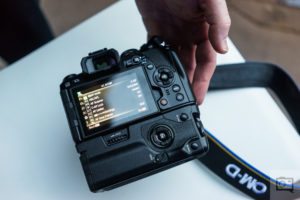
Photographing fireworks with John Cornicello Seattle-based photographer John Cornicello specializes in portraits, but has been photographing fireworks for years. He's presented a class on it for CreativeLive, and with the Fourth of July weekend upon us, we figured we'd take a look at some of the major takeaways from Cornicello's class.
For the nitty gritty details, check out Cornicello's blog post on the subject here. All images and content used with permission.
Location
Once the show starts, you're not likely to spend much time running around for different vantage points, although this of course depends on the length of said show. If possible, scout in advance, and look for clean views without power lines or trees in the way.
Scouting in advance is particularly advisable because it's harder to spot these distractions in the darkness, and if you're not careful, you can have black silhouettes intruding in your otherwise perfect image.
Looking for establishing landmarks can give your photos a little more context, to "establish a setting and help tell a story," Cornicello says.
Stability
Most obviously, a tripod is the best tool for the job here. If you don't have one and can't get one in time, other options – outdoor furniture, fenceposts, the roof of your car – can all work in a pinch, but you won't have the flexibility a tripod offers. *
If you must use those other options, keep in mind you can adjust the height angle of your camera with whatever props you can find to wedge underneath it; a wallet and cell phone combination can be all you need to get your lens up to the correct height.
If you have the means, a remote trigger can help keep the camera from moving at all from a press of the shutter button. Lastly, since you'll be focusing near infinity and likely not moving much, it's best to stabilize your focus by locking it in manual focus if your camera allows that.
* It's true that many cameras have extremely effective built-in image stabilizers these days, but few of them are up to multi-second shutter speeds, regardless of whether you're zoomed out or in. The possible exception may be Olympus' newer interchangeable lens models, but you're still likely to get more keepers by stabilizing your camera externally.
Exposure
Now this is one that Cornicello says people tend to overthink. As he says, 'Fireworks are bright!' You don't necessarily need to raise your ISO to astronomical levels or have a fast lens to get good results. So let's switch into 'Manual' mode and get everything dialed in.
Keep your ISO around 100 or 200 and stop down the lens – F8 is a good starting point, though Cornicello notes that displays have been getting brighter, so F11 or F16 may be necessary. Start with a 1/2-second or 1-second shutter speed time, and adjust your shutter speed from there as necessary depending on how many bursts you want to capture in a single image.
Also, it's okay to chimp here to check that your settings are working as intended – just don't get too carried away and miss the whole show.
And please, if your camera has a built-in flash, make sure it's disabled. "The flash won't help with the fireworks. . . but it will tend to annoy the people around you," Cornicello says.
Gear
You'll need a camera of some sort; having a full-frame DSLR or high-end mirrorless camera is obviously great, but even an app offering manual control of your smartphone camera will get you some usable images.
Zoom lenses are great for fireworks, as they let you change up your framing without having to leave your carefully scouted location. And since we're stopping down, even a kit lens with a basic interchangeable lens camera or fixed-lens camera will work fine.
Cornicello points out that a zoom lens not only allows you to zoom to change your composition between shots, but you can also experiment with zooming during your exposure; you can also play with the manual focus during your exposure to mix things up further. We've touched on this earlier, but if your camera or lens features in-camera stabilization, it's best to shut it off as they are mostly meant for handheld applications.
A few other goodies to have on hand? Cornicello recommends a small flashlight to help you change settings in the failing light, as well as extra batteries and a large memory card. Earplugs are, of course, down to personal taste and requirements.
The wrap
Photographing fireworks can be a fun way to turn a social outing you were already planning for into a photo outing with relative ease. If you're new to photography, or just got your first interchangeable lens camera or a pocket camera with manual controls, it's a great way to experiment and become more comfortable with exposure settings.
Head on over to John Cornicello's blog for, in particular, more details on exposure and useful gear to have for the occasion.
And of course, we mustn't forget the most important piece of advice Cornicello has to offer: Have fun!
Do you have any other tips or tricks you use when photographing fireworks? Have some images of your own you'd like to share? Let us know in the comments!
. dpreview.com2017-6-30 15:00


















